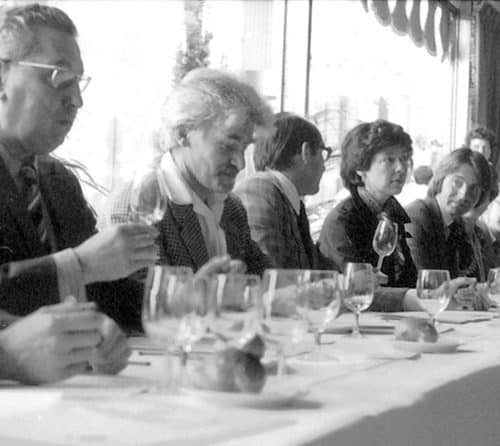Sonoma County’s Place in the Paris Tasting
By Virginie Boone
July 4th is always a good time to think back about the Paris Tasting (also called the Judgment of Paris) which was planned deliberately around the bicentennial of America’s independence in 1976 at a time when the only California wine readily available in Paris was Paul Masson.
One of its organizers, Patricia Gallagher, an American living in Paris, traced her family roots to 1630 colonial Massachusetts. As such, she was eager to put together a tasting of California wines for a French audience. She found an eager ally in British wine merchant Steven Spurrier, who ran a Paris-based wine shop and wine school, Académie du Vin, where Gallagher worked.
We’re all familiar with the shocking results – when a 1973 Stag’s Leap Wine Cellars Cabernet Sauvignon and 1973 Chateau Montelena Chardonnay from California were named king and queen of the ball over a selection of France’s finest wines, in addition to other wines from our state.
However, while there were no wines in the tasting from Sonoma County per se, Sonoma County grapes factored heavily into one of the winning wines.
While Calistoga-based Chateau Montelena was waiting for Cabernet Sauvignon plantings to mature, what it thought would be its signature grape, it was buying Chardonnay grapes from growers around the region. In 1973, that included 14 tons from Charles Bacigalupi in the Russian River Valley and 20 tons from Henry Dick in the Alexander Valley.
Katey Bacigalupi recalls that her grandfather Charles Bacigalupi heard about Chardonnay for the first time in the 1960s, via University of California Sonoma County farm advisor Bob Sisson, who started telling Russian River Valley growers they should give it a try. In 1964, the Bacigalupis planted 14 acres of it, obtaining Chardonnay budwood from Karl Wente.
Henry Dick’s place was called Belle Terre Ranch. Today it grows 105 acres of Chardonnay, Riesling and Cabernet Sauvignon under the direction of Dick’s son Ron. Chateau St. Jean has made a vineyard-designate Belle Terre Chardonnay since 1975.
But while Chardonnay was a white wine grape on the rise in the early 1970s, until the Paris Tasting Chateau Montelena produced and sold twice as much Riesling as Chardonnay.
[An interesting aside. One of the general partners of Chateau Montelena in the 1970s was shopping center developer Ernest W. Hahn, who developed Santa Rosa Plaza in 1983. Hahn’s lawyer was Jim Barrett, a legal specialist in developing and operating shopping centers who was the winery’s other general partner. The Barrett family continues to own and operate Chateau Montelena.]
In the spring of 1973, Montelena winemaker Mike Grgich started visiting these Chardonnay vineyards from which he was sourcing. Though he was said to have sought good relations with his growers, he did want things done a certain way, opting to only irrigate the vines once, in the middle of summer, rather than once a week, which was what UC Davis was advising at the time.
Grgich had the grapes picked when they hit an average of 23.5 degrees Brix, put in 45-pound boxes, brought over to the winery in gondolas, destemmed and pressed using what was then a new bladder-squeezing technology we now call a bladder press. After pressing, the Chardonnay was pumped into jacketed stainless-steel tanks, with the skin and seeds removed.
That vintage did not require any acid additions, and the grapes were fermented with a yeast known as French White. Fermentation temperatures were kept between 40 and 50 degrees and malolactic fermentation did not occur.
The wine was moved into once-used French Limousin oak barrels in November at an alcohol level of 13.2 percent, a residual sugar reading of 0.1 percent and acidity of 0.68 percent. Barrels of the Chardonnay were blended together and bottled in December 1974, resulting in a total of 2,200 cases in all.
The wine was then released in September 1975 for $6.50 a bottle.
As we have known since the fateful tasting of 1976, the 1973 Chateau Montelena Chardonnay came in first place out of a total of 10 wines. When it was announced, Time reporter George M. Taber was confused.
“The French word in the winning wine’s name had momentarily thrown me,” he recalled in his book, Judgement of Paris: California vs France and The Historic 1976 Paris Tasting That Revolutionized Wine. “’Chateau Montelena is Californian, isn’t it?’ I asked a bit dumbfoundedly.”
Yes, it was. The tasting took place on May 24, 1976. It was immortalized in Taber’s story about it for Time on June 7, 1976. On June 9, 1976, Frank Prial of The New York Times wrote about the Chardonnay specifically, helping to christen a golden era for American wine.
“The fact is that the best American vineyards and wineries can produce extraordinary wines,” he wrote.
He also mentioned that these premium wines, “in extremely short supply cost a great deal of money – anywhere from $6 to $20 a bottle.”
They cost a lot more than that now. Deservedly so. This Independence Day, raise a glass to the chutzpah and vision of a ragtag group of people in 1976 who strove to show what California could do, from the growers and the winemakers to the merchants and the journalists.
Image by Grgich Hills Estate


